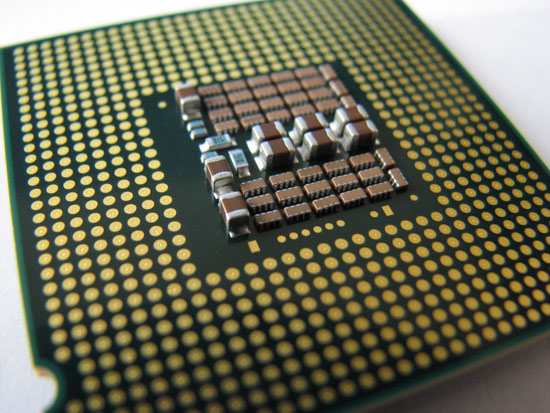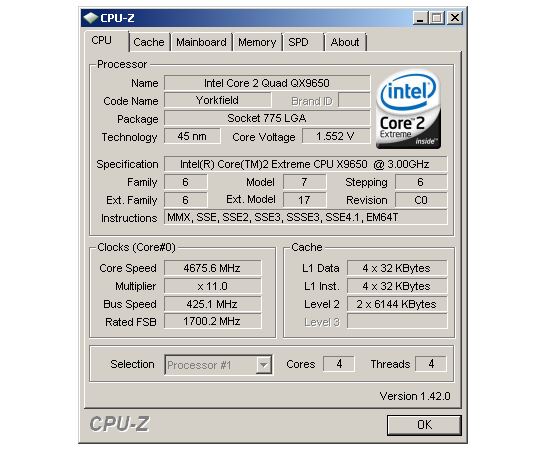Overclocking Intel's New 45nm QX9650: The Rules Have Changed
by Kris Boughton on December 19, 2007 2:00 AM EST- Posted in
- CPUs
Introduction
Intel has once again re-energized the overclocking community with the recent release of the Core 2 Extreme QX9650 quad-core processor, the first of many new mobile, desktop, and server CPUs fabricated using their radically new 45nm process technology. Early results have highlighted Intel's extremely conservative approach in assigning processor power specifications and because of this, users looking to push their systems beyond rated speeds are finding they have a lot more headroom than normally expected. Our overclocking trials have met with great success, as exploiting this processor's hidden performance margin is easier than ever imagined.
The last seven generations of Intel processors have utilized traditional metal oxide semiconductor (MOS) materials, namely silicon dioxide (SiO2) and other polysilicates. This has spanned a period starting with the Pentium, originally built on 0.6 micron (600nm) node technology, all the way to Core 2 Duo/Quad parts built on 65nm. However, for the first time in over 40 years, Intel has significantly changed some of the basic components used in transistor fabrication. Hafnium dioxide (HfO2) has replaced SiO2 as the gate dielectric material, along with other carefully chosen new metals, for use in the formation of gate electrodes in both PMOS and NMOS transistors. These new materials, along with the right process recipe, have cut gate leakage by a factor of more than 10x while simultaneously delivering an astonishing 30% decrease in transistor switching energy. The result is a cooler running, more energy efficient, and high-performance processing powerhouse.

Intel's Core 2 Extreme QX9650 in the classic LGA775 package
Moving to a smaller node process technology allows for the potential of two things to happen. The first is the ability to make smaller production dies, reducing manufacturing costs, and ultimately making products more affordable to the consumer. Alternatively, designers can take advantage of the increased transistor density made possible by the new process and develop next-generation solutions that pack even more transistors into the same space as before. Smaller transistors also allow Intel to take advantage of lower switching energies up to a limit. This is true until smaller and smaller transistor gate dielectric boundary layers create conditions in which power leakage - even with the transistors in the "off" state - become excessive. From this point on something will have to change if Moore's "Law" is going to continue.
With much fanfare, Intel released the highly anticipated Core 2 Extreme QX9650 Processor just a few shorts weeks ago, knowing that the high price would be little more than a speed bump for high-performance enthusiasts. More practical-minded users will have to wait until early 2008 before experiencing the mainstream release. Naturally, we wasted no time in bringing you this first-hand look at the QX9650's expansive overclocking potential. Although our experience has not been entirely without problems - we will cover the good and bad later in more detail - we must commend Intel on the development of another great product. Without a doubt, the QX9650 has taken its rightful place in the winner's circle.

Our maximum overclock on water is nothing short of impressive
Until now, achieving this level of overclock with water-cooling alone was unheard of and we find ourselves feeling punch drunk with the speed. Indeed, finding applications that make practical use of this ridiculous amount of processing power is exceedingly difficult - few programs these days efficiently utilize two cores, let alone four. Obviously, scenarios that make intelligent use of the QX9650's exceptional parallel processing capabilities stand to benefit the most. Good examples are video (and to a lesser extent audio) editing, rendering, ray tracing, 3D modeling, DivX/Xvid encoding operations, and of course gaming (when properly coded and without GPU limitations).
We hope our in-depth look at QX9650 overclocking will provide new information even for those who have been into the overclocking scene for some time. Others, looking for the right opportunity to try their hand at voiding their processor's warranty, should find just about everything they need get started down the long path towards an overclocking addiction. Strap on your heatsinks, tweak your voltages, and join us as we see exactly what Penryn and 45nm brings to the overclocking party.










56 Comments
View All Comments
Griswold - Thursday, December 20, 2007 - link
I think the other explanation for the delay is much more likely than this horsecrap.tomoyo - Wednesday, December 19, 2007 - link
This is a great article from both a readability and technical standpoint, I found it very enjoyable to actually read the commentary, which I cannot say is true for 95% of tech reviews. Also the graphs and information presented were extremely useful. I love the demystifying of the vdroop issue to prove that it's a GOOD thing.Amiteriver - Wednesday, December 19, 2007 - link
Finally a review with some understandable explanations of Bios settings and there realation ships. As the motherboards change you get new Bios names for things and your eyes glaze over wondering what the heck some of the terms mean. Look forward to future articles of popular motherboards Bioses. I will be printing this article out. Thanks muchAmiteriver - Wednesday, December 19, 2007 - link
Finally a review with some understandable explanations of Bios settings and there realation ships. As the motherboards change you get new Bios names for things and your eyes glaze over wondering what the heck some of the terms mean. Look forward to future articles of popular motherboards Bioses. I will be printing this article out. Thanks muchSczee - Wednesday, December 19, 2007 - link
Quite possibly the best article on computer hardware I have ever read. I learnt a lot about overclocking from it and plan to put it to use tonight. I'll be looking out for your next piece Kris.Bozo Galora - Wednesday, December 19, 2007 - link
ya, the X48 is being delayed because some top tier mobo manuf needs to get rid of its X38 inventory. My guess is Asus, because they have the muscle to influence Intel. Bleh.So I bought all this super xmas bargain stuff, and now I am going to have to let it gather dust - lol
http://www.digitimes.com/mobos/a20071217PD205.html">http://www.digitimes.com/mobos/a20071217PD205.html
Bozo Galora - Wednesday, December 19, 2007 - link
and the X48 does seem to have a 450-460 cap, at least so farhttp://en.hardspell.com/doc/showcont.asp?news_id=1...">http://en.hardspell.com/doc/showcont.asp?news_id=1...
bryanW1995 - Wednesday, December 19, 2007 - link
Best article I've read here in a long time. Good job.Regs - Wednesday, December 19, 2007 - link
So lets say I have a 65nm Core Duo running between 0.850V-1.3525V. These are the product specs, which I guess .850 is the low limit and 1.325 is the high limit. Why does the voltage have to decrease depending on load? Is it just as simple as "supply and demand"? How does running the CPU at 1.352v run the risk of instability?Aivas47a - Wednesday, December 19, 2007 - link
Great article. You guys have really been distinguishing yourselves with in-depth work on overclocking the last few months: exploring obscure bios settings, tinkering with "extreme" cooling -- keep it up!My experience with a qx9650 so far is very similar to yours: easy scaling to 4 ghz, difficult scaling after that with 4.2 ghz being the practical max for regular operation (folding, etc.).
One issue I will be interested to see you address in the future is fsb overclocking on yorkfield. So far I am seeing yorkfield top out at lower fsb (450-460) than was possible for kentsfield on a comparable P35 or X38 platform. That is not so significant for the unlocked Extreme Edition chips, but could make it difficult to achieve the magic 4 ghz with the q9550 and especially the q9450.